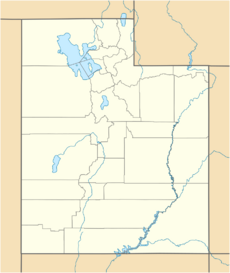Earth:The East Temple
| The East Temple | |
|---|---|
 The East Temple, west aspect | |
| Highest point | |
| Elevation | 7,709 ft (2,350 m) [1] |
| Prominence | 1,709 ft (521 m) [1] |
| Parent peak | The West Temple (7,810 ft)[2] |
| Isolation | 3.9 mi (6.3 km) [2] |
| Coordinates | [ ⚑ ] : 37°13′14″N 112°57′03″W / 37.220681°N 112.950914°W [1] |
| Geography | |
| Location | Zion National Park Washington County, Utah United States |
| Parent range | Colorado Plateau |
| Topo map | USGS Springdale East |
| Geology | |
| Age of rock | Jurassic |
| Type of rock | Navajo sandstone |
| Climbing | |
| First ascent | 1937 |
| Easiest route | class 5.4 climbing[2] |
The East Temple is a prominent 7,709 feet (2,350 m) summit composed of Navajo Sandstone in Zion National Park, in Washington County of southwest Utah, United States .[3] It is one of the notable landmarks in the park. The nearest neighbor is Twin Brothers, one-half mile to the north, and the nearest higher peak is The West Temple, 3.85 miles (6.20 km) to the west-southwest.[1] The mountain is situated 1.8 miles northeast of the park headquarters, at the confluence of Pine Creek and the North Fork Virgin River. This feature's name was applied by John Wesley Powell during his explorations in 1872, and was officially adopted in 1934 by the U.S. Board on Geographic Names.[3] The first ascent was made in 1937 by Glen Dawson, Dick Jones, Homer Fuller, Wayland Gilbert, and Jo Momyer.[4]
Climbing Routes
Climbing Routes on The East Temple[5]
- Casual Route - class 5.4 - 4 pitches
- Fang Spire - class 5.9 - 5 pitches
- Lovelace - class 5.10 - 9 pitches
- Cowboy Bob Goes to Zion - class 5.10 - 10 pitches
- Mobius - class 5.11 - 5 pitches
Climate
Spring and fall are the most favorable seasons to visit The East Temple. According to the Köppen climate classification system, it is located in a Cold semi-arid climate zone, which is defined by the coldest month having an average mean temperature below 32 °F (0 °C), and at least 50% of the total annual precipitation being received during the spring and summer. This desert climate receives less than 10 inches (250 millimeters) of annual rainfall, and snowfall is generally light during the winter.[6]
Gallery
See also
- Geology of the Zion and Kolob canyons area
- Colorado Plateau
References
- ↑ 1.0 1.1 1.2 1.3 "The East Temple, Utah". http://www.peakbagger.com/peak.aspx?pid=3845.
- ↑ 2.0 2.1 2.2 "East Temple, The - 7,709' UT". https://listsofjohn.com/peak/20291. Retrieved 2020-10-18.
- ↑ 3.0 3.1 U.S. Geological Survey Geographic Names Information System: The East Temple
- ↑ A Brief History of Climbing in Zion. bigwalls.net
- ↑ The East Temple Mountain Project
- ↑ "Zion National Park, Utah, USA - Monthly weather forecast and Climate data". Weather Atlas. https://www.weather-us.com/en/utah-usa/zion-national-park-climate.
External links
- Zion National Park National Park Service
- Weather forecast: The East Temple
 |








